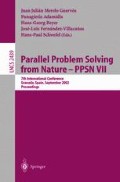Abstract
Fitness evaluation is often a time consuming activity in genetic programming applications and it is thus of interest to find criteria that can help in reducing the time without compromising the quality of the results. We use well-known results in statistics and information theory to limit the number of fitness cases that are needed for reliable function reconstruction in genetic programming. By using two numerical examples, we show that the results agree with our theoretical predictions. Since our approach is problem-independent, it can be used together with techniques for choosing an efficient set of fitness cases.
Access this chapter
Tax calculation will be finalised at checkout
Purchases are for personal use only
Preview
Unable to display preview. Download preview PDF.
References
D. Applebaum. Probability and Information: An Integrated Approach. Cambridge, Cambridge, UK, 1996.
W. Banzhaf, P. Nordin, R. E. Keller, and F. D. Francone. Genetic Programming, An Introduction. Morgan Kaufmann, San Francisco CA, 1998.
C. Gathercole and P. Ross. Dynamic training subset selection for supervised learning in genetic programming. In Y. Davidor, H.-P. Schwefel, and R. Männer, editors, Parallel Problem Solving from Nature-PPSN III, volume 866 of Lecture Notes in Computer Science, pages 312–321, Heidelberg, 1994. Springer-Verlag.
C. Gathercole and P. Ross. Tackling the boolean even N parity problem with genetic programming and limited-error fitness. In John R. Koza, Kalyanmoy Deb, Marco Dorigo, David B. Fogel, Max Garzon, Hitoshi Iba, and Rick L. Riolo, editors, Genetic Programming 1997: Proceedings of the Second Annual Conference, pages 119–127, San Francisco, CA, USA, 1997. Morgan Kaufmann.
S. Haykin. Neural Networks: A Comprehensive Foundation. Prentice-Hall, London, UK, 1999.
W. D. Hillis. Co-evolving parasites improve simulated evolution as an optimization procedure. In C. G. Langton, C. Taylor, J. D. Farmer, and S. Rasmussen, editors, Artificial Life II, volume X of SFI Studies in the Sciences of Complexity, pages 313–324, Redwood City, CA, 1992. Addison-Wesley.
P. Nordin and W. Banzhaf. Genetic programming controlling a miniature robot. In E. V. Siegel and J. R. Koza, editors, Working Notes for the AAAI Symposium on Genetic Programming, pages 61–67. MIT Press, Cambridge, MA, 1995.
B. J. Ross. The effects of randomly sampled training data on program evolution. In D. Whitley, D. Goldberg, and E. Cantu-Paz, editors, GECCO 2000 Proceedings of the Genetic and Evolutionary Computation Conference, pages 443–450. Morgan Kaufmann, 2000.
S. M. Ross. Introduction to Probability and Statistics for Engineers and scientists. Academic Press, New York, 2000.
Author information
Authors and Affiliations
Editor information
Editors and Affiliations
Rights and permissions
Copyright information
© 2002 Springer-Verlag Berlin Heidelberg
About this paper
Cite this paper
Giacobini, M., Tomassini, M., Vanneschi, L. (2002). Limiting the Number of Fitness Cases in Genetic Programming Using Statistics. In: Guervós, J.J.M., Adamidis, P., Beyer, HG., Schwefel, HP., Fernández-Villacañas, JL. (eds) Parallel Problem Solving from Nature — PPSN VII. PPSN 2002. Lecture Notes in Computer Science, vol 2439. Springer, Berlin, Heidelberg. https://doi.org/10.1007/3-540-45712-7_36
Download citation
DOI: https://doi.org/10.1007/3-540-45712-7_36
Published:
Publisher Name: Springer, Berlin, Heidelberg
Print ISBN: 978-3-540-44139-7
Online ISBN: 978-3-540-45712-1
eBook Packages: Springer Book Archive

